First-time visitors to Silicon Valley are often struck by how underwhelming it is—a collection ofoffice parks, freeways, and suburbs that doesn’t feel like the font of a revolution. But don’t let theordinariness fool you: Silicon Valley is less a place than a state of mind, and the technologies and productspouring out of its sprawling campuses have dramatically changed the ways we work and live. Within the last fewyears, the region has also begun to put a big imprint on philanthropy.
In 2017, the 50 largest individual donors in the U.S. gave away $15 billion. Fully 60 percent of those bigfootgifts came from tech titans, according to the Chronicle of Philanthropy. As recently as 2013, only aquarter of America’s top-50 gifts were from barons of the technology industry.
In addition to the surge of resources they are pouring into charitable giving, tech entrepreneurs are also bringingtheir potent optimism, and a willingness to pursue high goals. They understand that taking risks is part of allinnovative problem-solving. They tend to be methodical in researching issues, and disciplined in learning andimproving over time.
Those sorts of virtues have made Bill and Melinda Gates, for instance, some of today’s most consequentialdonors. Their vaccine program alone—which is just one portion of their vast philanthropic effort—isestimated to have saved the lives of 8 million preschool children in its first two decades of operation. (Gates,though, is something of a hybrid—mixing tech-philanthropist strengths with some of the more patient andcollaborative qualities of earlier donors in the Rockefeller/Carnegie/Rosenwald mold.)
Philanthropy in Silicon Valley has existed for some time—the Hewletts and the Packards became important giversdecades ago. But the deepening of digital fortunes, and spread of tech perspectives, is now adding a distinctcoloration to American charity as a whole. If we define “Silicon Valley” as not just the SanFrancisco-San Jose corridor but also Seattle and the technology-centered pockets of Boston, New York, L.A., Austin,and other places, we can see that the philanthropy emerging from these tech hubs has some common tendencies:Data-driven decisions. Heavy donor involvement in grantmaking, program management, and evaluation. Gifts (often ofa huge size) that seek to transform whole sectors. Wariness and even scorn for traditional charitable causes andinstitutions. Strong demand for national and global effects.
The new tech moguls are determined to upend philanthropy as they have communications, publishing, entertainment,travel, news, retailing, transportation. There are lots of aspects of this to be excited about, and plenty to worryover. With the principles and perspectives of Silicon Valley increasingly suffusing the charitable world as they dothe rest of our culture, it’s a good time to look closely at what this might mean for giving in America.
Surprises on generosity
The first surprise to many Americans will be that, despite the visibility of powerful givers like Gates and MarkZuckerberg, the tech class as a whole is not especially generous. The definitive “How America Gives”database maintained by the Chronicle of Philanthropy shows that tech cities like San Francisco (where 2015charitable contributions were 2.7 percent of local income), Seattle (3.0), and Austin (3.0) lag behind places likeSalt Lake City (5.5), Memphis (5.6), Atlanta (4.6), Nashville (4.0), Grand Rapids (4.6), Jacksonville (4.2), Dallas(3.8), Charlotte (3.6), and Houston (3.7) in household giving.
Giving rates in tech-dominated regions seem to be rising, but the IRS statistics collated in “How AmericaGives” show that techies earning $100,000 to $200,000 are still significantly less beneficent than manyothers with equivalent incomes. One thing keeps the overall donating pace of the computerati from being even moredisappointing: the very richest have been making some massive gifts. There are now at least 70 billionaires, andmore than 75,000 millionaires, just in the small region hugging the west and south shores of San Francisco Bay, andsome of the most wealthy have signed the Gates-Buffett “Giving Pledge” committing to give away at leasthalf of their fortune. As it is increasingly loosed into the philanthropic sector, this money will reshapeimportant parts of American charity.
Some of today’s tech philanthropy is already going into very unconventional places. For instance, SiliconValley luminaries like Larry Ellison, Peter Thiel, Sergey Brin and Larry Page, and others have put up billions tofund “life-extension” research. “Death makes me very angry,” Ellison has said. He openlyproclaims his hope to live forever, and has given about a half-billion dollars in pursuit of that goal.Google’s investment is far bigger. Hundreds of individual techies who fear they may reach their end beforethe life-extension scientists have got their app working are making arrangements to have their bodies frozen, inthe hope they can someday be revived.
World change
A similar millenarian streak can be seen in the open planning of Jeff Bezos to seed human beings into space so thatwhen Earth wears out, vast numbers of us will be living elsewhere. “The solar system can easily support atrillion humans,” he enthused in a 2018 interview in Berlin (without indicating how today’s mere 8billion people will produce that many homo sapiens). “That’s the world that I want mygreat-grandchildren’s great-grandchildren to live in.” (See our article on the investments of Bezos andElon Musk in space, starting on page 34.)
Even much shorter-range philanthropic projects backed by Silicon Valley fortunes often begin with relativelyunbounded donor demands. When Mark Zuckerberg and his wife announced they would steer nearly all of their Facebookstock into philanthropy, they said they were aiming during the lifetime of their child to “cure, prevent, ormanage all diseases”—all diseases, they repeated—on the way to an average lifespan of100 years.
“The rest of us concern ourselves with individuals, neighborhoods, communities, all of which can beimproved,” writes Felix Salmon in Wired. Tech billionaires, though, focus on “the whole world,and even hypothetical future worlds.” There is more than a whiff of the superman in such enterprises. Theintense abstraction at the core of this type of philanthropy causes Silicon Valley donors to jump completely overand around messy human variables like psychology, history, emotion.
In A Truck Full of Money, his book about Internet pioneers, Tracy Kidder collects examples of theirlanguage and logic. Aspirations are always “universal,” “futuristic in vision,”“disruptive at their core,” “fundamentally game-changing,” able to “revolutionizeevery aspect of everybody’s life,” and aimed at “tens of millions” of people—inshort, a “smorgasbord of awesome.” In the tech world, notes software pioneer Donald Knuth,“nothing over 30 months old is trustworthy or interesting.”
George Gilder, author of the new book Life After Google, recently had an exchange with Forbeseditor Rich Karlgaard on the high mix of sci-fi fixation, militant materialism, and cognitive elitism thatdominates Silicon Valley. Karlgaard describes the philosophy that reigns in the Valley as “a throwback to theProgressive Era of the early twentieth century. The idea that…the smartest people should run society alongscientific management principles. Life organized as a Frederick Taylor factory.”
Gilder: I think you’re right. A lot of people have an incredible longing to reduce humanintelligence to some measurable crystallization that can be grasped, calculated, projected, and mechanized….
Forbes: Having lived my adult life in Silicon Valley, I think today’s dirty secret is a kindof nerd fascism, wherein it’s thought that only the highest IQs have legitimacy…. The highest IQ peoplehave a tendency to want to reduce everything to algorithms and predictability, but in doing so, they cut out thesurprise. Yet all great discovery and innovation, by definition, comes as a surprise.
Gilder: Yes, they’re destroying information rather than expanding it. If something’sdeterminist, it can’t generate information. As Claude Shannon showed, information is the unexpected bits.
As examples of places where technical intelligence has become disconnected from true wisdom, Gilder citestoday’s mania among tech elites that artificial intelligence will soon make computers so smart they’llwrench control of the future from human beings. He describes this as “provincialism and myopia, exaggeratingthe significance of the attainments of their own era, of their own companies, of their own special philosophies andchimeras—of themselves, really.
Of course, during their business activities, the cold disciplines of economics and practical realities of humannature act as moderating forces against speculative fantasies. But when tech moguls turn to philanthropicaspirations, there are fewer checks on their utopian demands and push toward quantification, abstraction, andsystemizing. The money gushing out of Silicon Valley today is thus importing into our charitable activities somepronounced new values and practices. There is the obsession with data. A preference for the impersonal anduniversal over the personal and particular. Demand for approaches that aggregate and simplify humans and theirneeds, in order to push large “scale.” Huge assumptions are often made that cultural problems can besolved with technical fixes. There is a focus on the national and global over the local. And—always—theassumption that people, cultures, and societies need “transformation.”
Spreadsheet philanthropy
Laura Arrillaga-Andreessen, daughter of a Silicon Valley real-estate baron and wife of a software mogul, is anenthusiastic advocate of this approach. She directs the Laura Arrillaga-Andreessen Foundation, a kind of missionarygroup for other givers. In her own words, her foundation is a “philanthropic innovation lab” that usestechnology to “globally scale open-source education innovations to help individuals elevate theirgiving.”
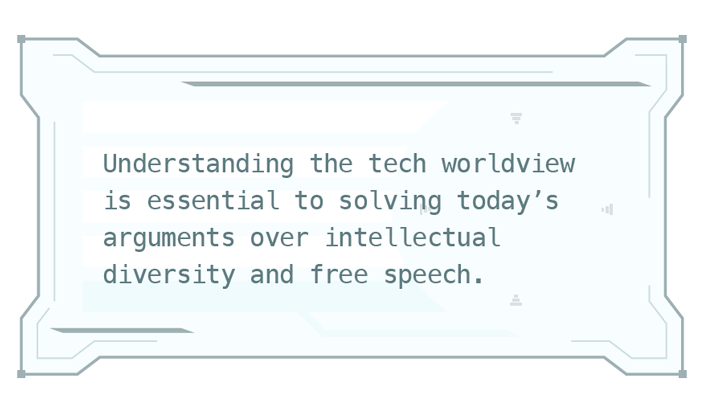
Arrillaga-Andreessen is an energetic advocate for “disrupting” traditional philanthropy, which shedepicts as hidebound, inefficient, and driven by emotion, and replacing it with “proactive, strategic”donors who network with similar peers online, share tips in web forums on successes and failures, and receiveinstant feedback from grantees through text messages and smart-phone updates. “It is hard to underestimatethe extent to which technology could improve philanthropy,” she enthuses in the Stanford SocialInnovation Review. She hungers for a future where, for instance, “data of billions of people”are collected through things like blood tests and “mined and utilized for good in an instantaneousmanner…shattering…the system as we know it.”
Arrillaga-Andreessen teaches all of this from a high pulpit at the Stanford Business School, and she has distilledthe message into an online course available at her foundation’s website. Her videos walk would-be donorsthough a multi-step method for giving. First, identify a social issue and develop your own “theory ofchange” on how to solve it. Then, using online sources and personal contacts, create “landscapemaps” that “roughly illustrate the complex environment or ecosystem surrounding any socialproblem” and “lay out key stakeholders and both supporting and opposing forces.” Next, use thosemaps and quantitative charity evaluators such as GuideStar to determine which nonprofits are pursuing“intervention strategies” that reflect your theory of change. Finally, contact potential grantees toconfirm the fit between that group’s intervention strategy and your personal theory of change. After a grantis made, ensure that the nonprofit vigorously implements the intervention strategy by requiring metrics, reports,evaluations, real-time site visits, and “end-of-grant life cycle reports.”
If this sounds like a lot of work, it is—and can be a particular burden for charities working in the messyworld of helping hurting people, rather than promoting large-scale systems change. Arrillaga-Andreessen offerscautionaries about not hijacking a nonprofit’s programs, or making so many data requests as to overwhelmgroups. But to charity workers up against hard human ills, this business-school approach will inevitably involve alot of time jaw-boning, making spreadsheets, and writing reports. Some would-be beneficiaries have updatedthe ancient cautionary: Beware geeks bearing gifts.

Missing community
One doesn’t really need a theory of change or a complex landscape map to, say, mentor fatherless children. So,not surprisingly, very little tech philanthropy today goes to that kind of grassroots charitable assistance.Pressing human problems like addiction, domestic abuse, persistent poverty, mental illness, foster care, lonelyelders, declining personal responsibility, and others that are not amenable to brisk quantification, that requirehands-on human intervention, that involve moral judgment, are issues that Silicon Valley donors generally avoid.
Technical fixes always trump human-to-human suasions (one nonprofit leader recently shared with Philanthropythe detailed pitch he got from a tech enthusiast for a phone app he believed would solve homelessness). Instead ofintimate, individual human service, tech donors put a strong emphasis on policy change. And rather than givinglocally where they can accurately identify need, observe results, and interact personally with participants (asmost American philanthropists prefer), tech givers have a decided penchant for global or nationwide causes. Theportion of Silicon Valley’s giving that goes to charities in Silicon Valley is vanishingly small.
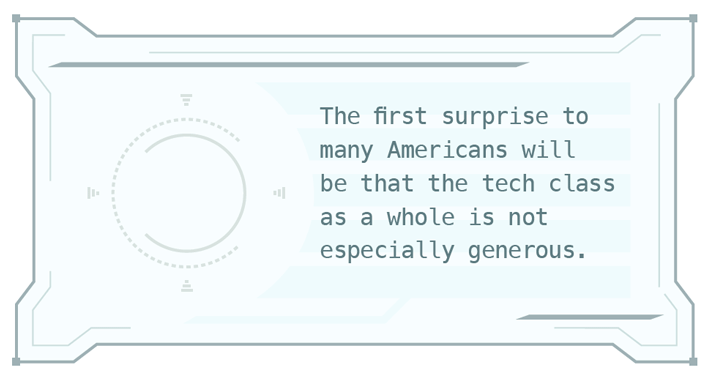
A 2016 report titled The Giving Code (funded by the David and Lucile Packard Foundation) found that just7 percent of all donations by Silicon Valley private foundations was directed to nonprofits in the Valley. And lessthan half of that went to truly local organizations, as opposed to large institutions like universities orhospitals.
Everywhere else in America, the local community foundation has a special focus on the immediate needs of the hostarea. Thanks to tech donors, the Silicon Valley Community Foundation is by far the largest in the country, with $13billion in net assets, making it richer than the Ford Foundation. Yet most of its grants are shipped off far fromhome. SVCF “should take the ‘community’ out of its name,” says Bill Somerville, who ran oneof the two community foundations that merged in 2007 to become SVCF, before it mushroomed with tech wealth.“They don’t really focus on this community at all.” The organization had thoroughly internalizedthe local culture’s mania for growth, “scale,” “disruption,” and nationaleffects—even opening East Coast offices to raise (and spend) money thousands of miles from its hometurf.
Meanwhile there is plenty of charitable need in Silicon Valley. The income gap between high earners and low earnersis wider here than in any other place in America—and worsening. On the one hand, workers at Facebook got amedian pay package of $240,000 in 2017. At Google’s umbrella company (Alphabet), median pay was $197,000. InSilicon Valley as a whole, the average annual wage ($112,060) was about twice the national average.
That average, though, hides the strain on non-tech workers in the region, who are in trouble. According to TheGiving Code, many formerly middle-class families in the area now regularly call upon food banks, clothingclosets, and even homeless shelters. Nearly 30 percent of all local residents depend on some form of public orprivate assistance.
The biggest problem is that all those high-paid tech employees have bid housing prices up to stratosphericlevels. The median home price in the Valley is well over a million dollars. The mortgage and taxes on such aproperty can beggar even a middle-class earner, much less a low-skill worker. And rents have skyrocketed intow.
The distorted housing costs of the Silicon Valley region are a big reason more than a fifth of all Californiansare now considered poor after adjusting for housing. That’s a much higher percentage than in any otherstate—including Appalachia or the deep South. Other residents are just keeping their heads above water. Astudy by the United Way found that one out of every three California families is barely able to pay its bills.
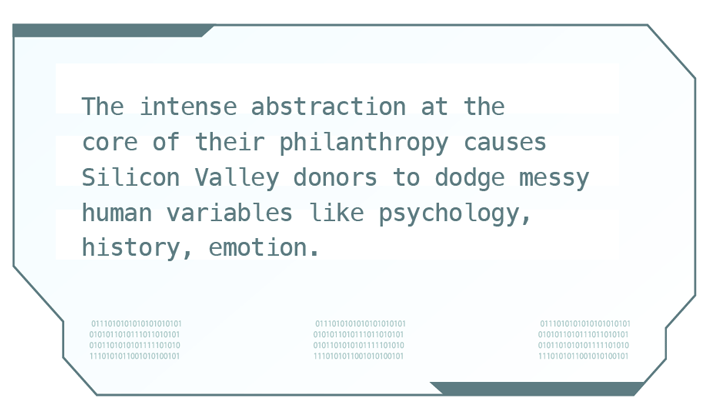
And it isn’t just a financial gap. There are also deep social needs in Silicon Valley. In a place with thehighest concentration of STEM degrees in the country, a shocking 45 percent of local eighth graders score belowproficient on state algebra tests. Area charities are strained to keep up with these needs—more than 30percent run operating deficits that exceed the national average, and half have less than three months ofoperating cash on hand.
Making space for altruism
With all this need, why the paltry rates of local giving? Rick Williams, a 20-year veteran in philanthropy andsocial services, is CEO of the Sobrato Family Foundation, a rare Silicon Valley funder that is almost completelyfocused on giving locally. (See our interview with founder John Sobrato on page 14.) To Williams, the lack of localgiving begins with the simple reality that the new tech philanthropists, by and large, aren’t from theValley. “People tend to give where they’re from, and this is not a place where many people haveroots.” He says he often meets tech workers in the Valley who have never visited the city of SanJose—the tenth-largest in the country, only 20 miles from the Stanford campus, but a locale outside much ofthe tech industry’s consciousness.
The continental and global orientation of tech philanthropy is also a reflection of the Silicon Valley ethos,Williams emphasizes. “For a lot of these donors, the work they do is changing the world. They thinkit’s natural that their giving should have the same kind of effect.” So they look over the horizon forsplashy national or international projects to support.
In hope of convincing some area donors that they don’t have to airmail their money to change people’slives, the Packard and Heising-Simons foundations (the latter founded by a computer-chip engineer) have teamed upto arrange short-term pairings of tech donors with leaders of local charities that meet urgent human needs.“We’ve really got two Valleys that co-exist,” says Jill Mitsch from Sacred Heart CommunityService, a San Jose immigrant-aid organization that has been one beneficiary. “Hopefully we can break thatdown.”
Mark Zuckerberg recently announced that Facebook would open facilities in 2019, called Community Hub, for use bycertain local nonprofits. And Google is already connecting some employees to Bay-area charities. In 2017 thecompany turned space on the first floor of its downtown San Francisco office into a place for “experientialevents” like the one that recently brought Googlers together with students and teachers from an East Oaklandcharter school. Justin Steele, who helps run the company’s corporate-giving program, recognizes that theaverage tech professional today has a strong bias toward big, quantitative, systemic efforts that upend traditionalpatterns—“similar to the values that guide many of the companies in Silicon Valley.” But hebelieves “there is true power in proximity,” and hopes that putting a face and personal story in frontof a software coder can spark interest. “A person needs to be close to an issue to have empathy,” saysSteele.
One group that has been feeding empathy and fueling generosity by wealthy Silicon Valley residents for two decadesnow is Legacy Venture. The group was founded by a couple of venture capitalists inspired by Bob Buford’s callfor busy professionals to make room in their lives for spiritual practice and assistance to others. A nonprofitventure-capital firm, Legacy accepts investments with the stipulation that the principal plus all gains earned overthe life of the investment must eventually go to charities selected by the investor.
The operation has been able to dramatically multiply initial gifts by 1) forgoing earnings of its own and chargingmanagement fees that are only a fraction of what other venture-capital funds collect, 2) using their deepconnections within Silicon Valley to put their money behind the most promising young firms (they have been earlybackers of companies like Skype, Fitbit, YouTube, Facebook, Twitter, and others), and 3) managing all investmentsfor maximum returns, knowing that every penny will go to philanthropy once cashed out. Wealthy executives from topSilicon Valley businesses have put up most of the $1.5 billion that Legacy is currently overseeing.
Some of the top private venture-capital firms in the Valley “like the idea that our returns go tocharity,” according to co-founder Russ Hall, so they often reserve portions of their deals for Legacyinvestors. For all of these reasons, Legacy’s gains outstrip most V.C. peers. And in the end it all goes tobeneficiaries like the American India Foundation, the Lucile Packard Foundation for Children’s Health,College Track, the African Wildlife Foundation, Malaria No More, Human Rights Watch, the Eastside CollegePreparatory School in East Palo Alto, and other domestic and foreign nonprofits.
Clients who are attracted to Legacy Venture by its efficiency at turning gift-money into even larger gifts oftenfind that the seminars and networking offered by the group are an unexpected bonus. Legacy tries to help donorsimprove the quality of their giving. It connects them with others who share common interests. And it feeds andreinforces habits of benevolence.
Praxis Labs is another interesting group that is taking many of the insights and strengths of the high-tech andstart-up cultures and applying them to cultural improvement from a Christian perspective. It operates a businessaccelerator in the mold of Silicon Valley’s Y Combinator, but including both for-profit and nonprofitentities. In addition to helping entrepreneurs find economic success, Praxis encourages them to create humane andbeautiful products, pursue moral accomplishment, and be generous to those in need of assistance and uplift.
Operating as a 501c3 charity, the Praxis business accelerator has supported more than 125 new ventures, with a 92percent survival rate, creating several thousand full-time jobs in the process. Its community includes more than500 investors and philanthropists, 250 mentors, and several hundred alumni. Its programs include labs wherestart-up ideas get fleshed out, academies for business founders and students who are interested in business,intensive mentoring opportunities, and gatherings where like-minded individuals can share ideas.
Co-founders Josh Kwan and Dave Blanchard, who live in Silicon Valley and New York City respectively, love and admirethe worlds of technology and entrepreneurship but hope to bring some “alternative imagination” intothose fields. Specifically, they try to make a place for religious wisdom. The HBO show “SiliconValley” once joked that you can be anything you want in Silicon Valley—except a Christian. Kwan andBlanchard tell young entrepreneurs that doesn’t need to be true, and their program encourages participants tobring faith into their business ventures, their investments, and their giving. “How can we be sure that whatwe’re designing is good for people, and not just good for us?” is an example of the kind of questionPraxis puts before the entrepreneurs and technology creators that it guides.
The herd of free minds
The favorite story line in Silicon Valley is man-against-the-world. The preferred self-image is the braveoutside-the-box thinker who flips conventional ideas upside down. But in politics, Silicon Valley is more like aherd of independent minds. It has become one of the most homogeneous and internally conforming parts of ourcountry.
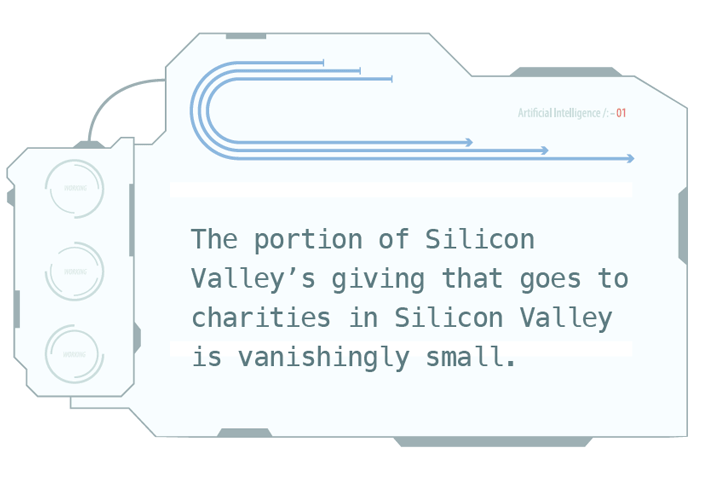
That can be seen in voting. San Mateo County, which covers much of Silicon Valley plus some rural areas, producedone of the most lopsided county votes in the entire United States in 2016: 76 percent for Hillary Clinton, 6percent for third-party candidates, 18 percent for Donald Trump. In the primary, Bernie Sanders got 41 percent ofthe vote. As Mark Zuckerberg acknowledged in his April 2018 testimony before the U.S. Congress, Silicon Valley is“an extremely left-leaning place.”
That was also the conclusion of a major 2017 study by researchers from Stanford. They surveyed more than 600“elite technology company leaders and founders,” almost all of them millionaires who are also active inphilanthropy. The findings document the strikingly uniform political orthodoxy of Silicon Valley. Just 8 percent ofthese tech barons voted for Donald Trump. Fully 96 percent favor same-sex marriage, 82 percent want universalhealth care even if it causes tax leaps, 79 percent support abortion, 82 percent want strong gun control. They aretwice as likely as the average Democrat to rank combatting climate change as “extremelyimportant.”

The researchers found that these Silicon Valley paragons have little interest in tradition, and little attachmentto any particular culture. They prize foreign travel. They place a high value on personal autonomy. Maximizingsatisfaction and personal development is their top priority. Or as Greg Ferenstein, another student of Valleyculture, put it, “The ultimate goal is to make life as close to the college experience as possible: a timededicated to exploration, while technology ensures that everyone has enough food and leisure to find their uniqueselves.”
A glimpse of this ethos as applied to philanthropy can be seen in a blog post written by Holden Larnofsky,co-founder of GiveWell, the charity evaluator favored by many prominent tech philanthropists. He describes on theGiveWell website “some of the deep value judgments and worldviews that underlie our analysis andrecommendations” as to which charities are most worthy of philanthropic support. GiveWell staff, he explains,are “global humanitarians…. We do not agree with the principle that ‘giving begins athome’: we do not assign more moral importance to people in our communities and in our country than toothers.” And GiveWell is “seeking to ‘accomplish as much good as possible’…not to‘ensure that we do no harm.’ ” The top goal is “improving humans’ control over theirlives and self-actualization.”
The Stanford study showed that there are just a few issues where wealthy techies differ from other down-the-lineprogressives: They don’t mind income inequality. They prefer increasing economic growth over closing incomegaps. They dislike unions. And they oppose government regulation of their economic markets.
Globalist in outlook, disconnected from local and national culture, resistant to personal restraints, opposed tolimiting by government or labor, supportive of an economic system that lavishly rewards winners while thegovernment redistributes wealth to the losers: this is Silicon Valley’s guiding spirit. That leaves littleoverlap with traditional American approaches to civil society, which emphasize local communities,neighbor-to-neighbor care, tightly knit families, religious support, and self-help.
The new tech elite want to liberate people from the traditional boundaries, guard rails, and constraints ofhuman history. They favor big, elite-driven, technocratic solutions to human problems: a caste of brilliantengineers at large companies wielding reams of intimate data on human actions to create new technologiescapable of altering society. The tech class aspires to bring mankind bounty extending far beyond old limits,and then distribute it using more data and dispassionate algorithms (in the process generating fantastic wealthand global power for the technocracy).
Politics and intellectual diversity
Back in the early days of the computer era, the common speculation on the psychology of our tech mandarins wasthat they would be libertarians—devoted to freedom both in economics and social life. That has not proventrue. Journalist Greg Ferenstein has undertaken detailed studies over many years of the political mindset inSilicon Valley. He and others have found that “Silicon Valley’s ideology is pro-market. But it isnot pro-liberty. Liberty is not a value. They are highly, highly collectivist.”
The fact that political and cultural views in Silicon Valley tend to be so monolithic has deep implications forsome of today’s most consequential debates on free speech, civility, and the role of technology. There isfast-growing concern today over the rise of numerous tech monopolies. Facebook has become the de factonewspaper of hundreds of millions of people. Google now picks the answers to two thirds of all the informationqueries made by Americans. Amazon sells half of all printed books and 80 percent of all ebooks, and collectshalf of all U.S. online retail spending. Apple recently became the first company to ever reach avaluation of $1 trillion. Amazon reached the $1 trillion value one month later. Five tech firms—Google,Facebook, Microsoft, Apple, and Amazon—now wield as much capital value as the GDP of any entire countryexcept the U.S., China, and Japan.
These companies constitute a dominating, near-universal presence in both the personal and professional lives ofAmericans. They set the rules. We follow them.
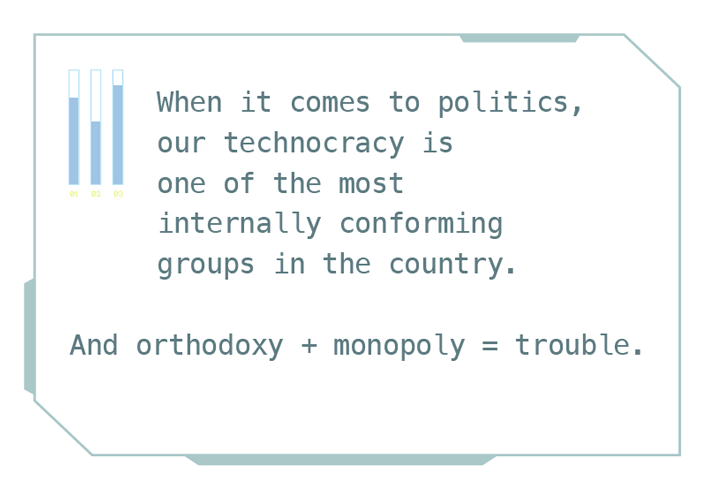
In the crucial public forums operated by technology companies, extremely opaque and seemingly arbitraryprocesses now regulate posting of videos, purchase of advertisements, inclusion in search results, and otheractions that have become central to participation in public life. Within the last year, authors andorganizations ranging from the Wall Street Journal to ProPublica have complained about having theircontent banned, deleted, warning-labeled, or “de-monetized” (stripped of ads or other moneymakingcapacity) by tech hubs.
Tech professionals often insist they are value-free and objective in their judgments. They are simply rationalscientists following the crumb-trails of facts to undeniable truths. The idea that the tech world could haveits own blind spots, selection biases, intrinsic desires to believe or disbelieve, its own parochial interests,is fiercely resisted. (The television show “South Park” created “Smug Alerts!” as theSan Francisco counterpart of L.A.’s smog warnings.)
The classical American tradition is that truth is best found through the vigorous competition of ideas. Let manyvoices and factions contend—fools and knaves included. Never anoint any in advance with the oil ofundeniability, or let certain participants harrumph that all experts agree, that an issue is“settled,” that citizens have a right not to be “offended,” that only certain points ofview may be aired.
American freedoms “rest on the assumption that the widest possible dissemination of information fromdiverse and antagonistic sources is essential to the welfare of the public,” ruled the U.S. Supreme Courtin the landmark Associated Press v. United States case that blocked commercial crimping of FirstAmendment free-speech rights. Yet many important issues that are vigorously contested across the U.S. are nowviewed as non-debatable within the narrow ideological confines of Silicon Valley. And many public-spiritedcitizens and philanthropic backers of wide participation in national affairs worry that this ideologicalnarrowness is increasingly being enforced in our new town halls—the online networks operated bytoday’s tech class.
Red lights flashing
It isn’t just people outside of the tech bubble who are concerned about this. At Facebook, a softwareengineer named Brian Amerige recently posted a statement on an internal message board under the title “WeHave a Problem With Political Diversity.” It explained, “We are a political monoculturethat’s intolerant of different views. We claim to welcome all perspectives, but are quick toattack—often in mobs—anyone who presents a view that appears to be in opposition to left-leaningideology…. We do this so consistently that employees are afraid to say anything when they disagree withwhat’s around them politically.”
This is bad for society, the message asserted, because “we are entrusted by a great part of the world to beimpartial and transparent carriers of people’s stories, ideas, and commentary.” The problem ofpolitical and cultural intolerance “has gotten exponentially worse” in the last two years, according toAmerige. He proposed that concerned workers form a group called “FBers for Political Diversity” toencourage broader thinking within the company. More than 100 Facebook staff quickly signed up.
Of course, there are 30,000 employees at the firm. And some of them immediately attacked Amerige and his newsupport group, then lodged complaints with managers asking that it be blocked as offensive. Given recentexamples where Silicon Valley dissidents have found that contradicting conventional wisdom can cost you yourseat at the table, this mini rebellion must be counted as brave.
In just the last few months, though, several more senior and secure insiders have presented their own warningsthat the tech industry is now bedeviled by resistance to ideas and evidence that don’t fit the prevailinggroupthink. Peter Thiel, who co-founded PayPal and nurtured many other star companies, recently excoriatedSilicon Valley as a blinkered “one-party state,” then announced he was moving his operations out ofthe region to get away from its intellectual narrowness.
Sam Altman, who runs the Y Combinator tech incubator (and is a political liberal), warned that Silicon Valleyculture is now too closed to unapproved points of view, and that “restricting speech leads to restrictingideas.” He complained that “it seems easier to accidentally speak heresies in San Francisco every year.Debating a controversial idea, even if you 95 percent agree with the consensus side,” is dangerous intoday’s Silicon Valley.
Michael Moritz, who helped launch Apple, Google, and many other tech firms, described the self-righteousbehavior he was seeing across Silicon Valley. “Complaints about the political sensibilities of speakersinvited to address a corporate audience, debates over the appropriate length of paternityleave…grumbling about the need for a space for musical jam sessions. These seem like the concerns of asociety that is becoming unhinged.” He warned that if censorious and entitled U.S. tech professionalsdon’t put an end to the distractions of today’s politically correct pampering and skirmishing,Chinese competitors may overwhelm them.
In a March 2018 New York Times story headlined “Silicon Valley Is Over, Says SiliconValley,” tech leaders working at a more middle level of the industry voiced similar concerns. Severalsaid they were considering leaving Silicon Valley to get away from its “left-wing echo chamber thatstifles opposing views.” A May 2018 Wall Street Journal article titled “Google vs. Google:How Nonstop Political Arguments Rule Its Workplace” describes endless politicization within the walls ofthe Internet’s leading search and advertising firm, and indicates that this is as bad for companyproductivity as it is for national intellectual balance.

Lincoln aims to emancipate
The overweening dominance of progressive views in Silicon Valley is the inspiration for one of the area’snew nonprofits. With the help of donors like the Searle Freedom Trust and the Bradley Foundation, a little bandof Silicon Valley insiders has created a philanthropy of ideas that is working against ideological distortionand unfairness in America’s technology heartland. Aaron Ginn left Texas with a degree in behavioraleconomics and Chinese and became a Silicon Valley specialist in using data science to market products and growcompanies. He is also an active Christian—in a place where religious observance has essentially had to“go underground,” as he puts it, to survive.
Ginn observes that tech workers who dissent from the Valley’s reigning pieties can face harsh personal andprofessional consequences. “A lot of people who work in the Valley were telling me, ‘I have to keepquiet about certain things I believe, or it’s going to be a problem at work.’ ” That cultureof self-censorship isn’t just bad for the individuals involved, and for America’s politicaltradition, Ginn believes. It is also bad for productivity and entrepreneurship. “A culture where peopleare afraid to speak up is not going to produce innovative thinking for too long,” he notes.
So Ginn and his friend and fellow tech worker Garrett Johnson—who has a master’s from Oxford, timeat a venture-backed tech startup, and some experience in politics—decided to do something about theproblem. They founded the Lincoln Network. It’s a nonprofit that provides ideas, research, contacts, andnetworking events for tech workers in Silicon Valley who are open to conservative, libertarian, religious, andother perspectives that are now frowned upon at many area companies and social organizations. Ginn and Johnson(who are both members of racial minority groups) would like to expand Silicon Valley’s appreciation ofdiversity to include the most fundamental variations among people—alternative ideals and worldviews.
One of their first projects was to find out how widespread the problem of self-censorship is in Silicon Valley.Like good software engineers, they collected data. The Lincoln Network commissioned a 2017-2018 survey ofnearly 400 tech professionals in Silicon Valley from across the political spectrum. Participants were askedabout their political and cultural beliefs and workplace norms.
The results were striking. Respondents overwhelmingly described their workplaces as liberal. And even amongworkers who are liberals themselves, there was strong worry and hesitation about expressing viewpoints thatdeviated from liberal orthodoxies. One tech worker reported he was gay and a lifelong Democrat, but alsoChristian, and that he thus felt he had to avoid sharing his views on some topics. “The idea of ‘Iagree with you 90 percent’ is not enough,” he wrote. Other survey participants said they carefullycensor their views on social media in order to avoid scrutiny at work or in job searches. Some recountedinstances of outright harassment at work based on political and religious views. A significant plurality ofright-leaning respondents said that the inability to be open about their political, religious, or culturalbeliefs prevented them from doing their “best work.” The report is available on Lincoln’swebsite at JoinLincoln.org/viewpoint-diversity.
In addition to documenting the challenges facing dissenters in the Valley, the Lincoln Network is looking to dosomething to increase intellectual tolerance and true inclusion in tech. The group sponsors events at whichparticipants can learn and discuss ideas, and connect with others willing to do likewise. It distributesresearch on public-policy issues with special relevance to the tech industry. It consults with nonprofits andadvocacy groups and donors who are focused on economic, religious, and personal liberty and helps themunderstand how they can use new technology to further their missions.
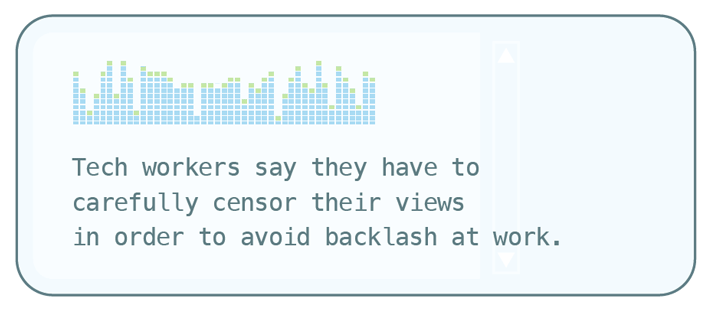
For Montgomery Brown of the Scaife Family Foundation—which has provided support for the Lincoln Networksince 2016—this aspect of Lincoln’s work has high potential. Lincoln’s consultancy services“allow a lot of other groups to do their work better.” He notes that Lincoln’s assistance isavailable to an “ecumenical” range of like-minded organizations, and goes beyond just technicalhelp into providing strategic thinking about where they can best direct their limited tech resources to get themost bang for their buck.
For instance, the group is currently building an easy-to-use online platform that public-sector workers liketeachers can use to request release from compulsory participation in union activities, now that the SupremeCourt’s Janus decision has given employees the right to opt out. Bringing the power of newtechnologies into advocacy is an area where the left has leapt far ahead, due to heavy pro bono and otherassistance from Silicon Valley workers. “There is a lot of work to be done” in helpingcentrist and conservative groups catch up in this area, according to Ginn. Lincoln has also partnered with anumber of state-based public-policy organizations, such as the Mackinac Center in Michigan and the EmpireCenter in New York, to assist them in getting wired for the future.
Perhaps most importantly, the Lincoln Network wants to lower barriers that keep economic libertarians, thereligiously observant, political conservatives, and others who don’t run with the prevailing grain of theBay area from getting jobs in the tech industry. “The Valley is where the work is being done that ismaking the future,” says Ginn. “People from all stripes of thinking need to be here.”
Justin Torres was a contributing editor to Philanthropy. Karl Zinsmeister oversees publications at The Philanthropy Roundtable.
